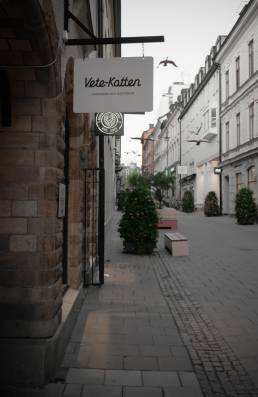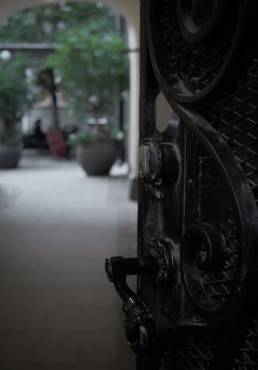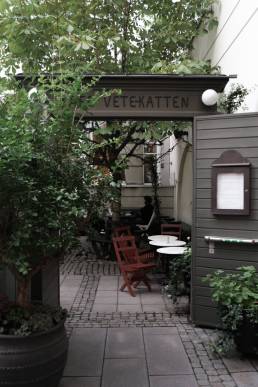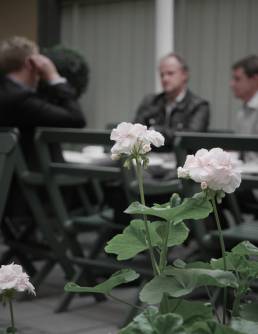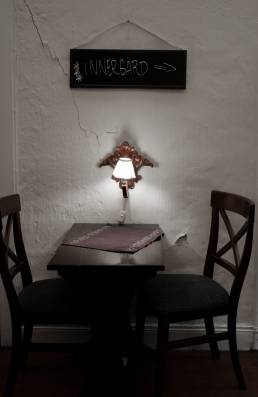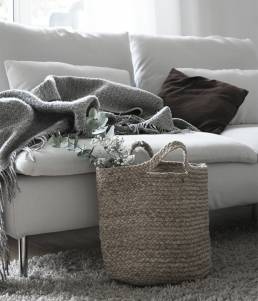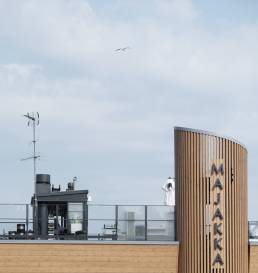DESIGN // NON-TOXIC FURNITURE
I love to keep my furniture for ages, so I get pretty excited when the time comes to bring something new into my home. I usually start my “furniture-hunt” at looking some interior magazines and Pinterest for inspiration and visiting all of my favorite showrooms to explore what is out there and all the possibilities that come with them. But it gets so hard when there are endless options out there and you want to make sure it’s just perfect for your home. My definition of perfect has changed over time and I’ve become more concerned with the health and safety and ethics of the products I purchase.
Before, I only cared about the look and the price. For my excuse, as a student, I couldn’t afford much anything else and quite frankly, didn´t had the patience to save up. Now that I´m getting older and wiser, my income is better, and I want my furniture to be good quality and non-toxic. I’m mostly drawn to wooden furniture, so I thought that would be fairly easy to find. But after some time I found that even natural materials can be glued, coated and treated with some pretty nasty stuff. After talking with few friends about it, I realised I´m not the only one with this problem how to find non-toxic furniture and differentiate from company’s so called “greenwashing”. my sense is that, industry-wide, sustainable furniture practices are advancing slowly despite the urgent need to transform almost every aspect of the furniture industry.
What is in it?
Sadly, I learned that most furniture are made with all sorts of harmful chemicals which I definitely wouldn’t want to bring into my home. It’s not nice to think that our indoor air quality is compromised by bringing in formaldehyde that can lurk in particle wood, or the glue vapours that are inside rugs, or the stain proof compounds that are sprayed on the couch and the list goes on. All of these nasties can easily turn our healthy sanctuary into a toxic minefield.
Basically, these tiny particles can float into the air we breathe and settle on the floor where our children and pets play. Without knowing it we inadvertently breathe the fumes, ingest the particles and absorb these contaminants into our skin.
These bad chemicals can give us headaches and rashes, make us drowsy and dizzy, they can also irritate our eyes, throat and lungs and trigger allergies. They also have been linked to messing with our hormones and contributing to a variety of serious health issues over time.
While it would be nearly impossible in today’s world to eliminate chemicals from our homes entirely, there are plenty of ways we can significantly reduce exposure. In this article, I’ll cover the common toxins to avoid in both new and second-hand furniture and the healthier, natural alternatives to choose in their place.
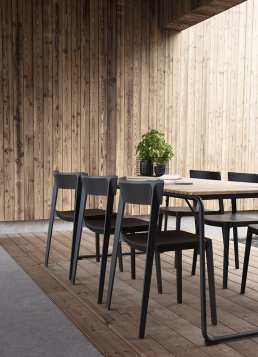
1. Go with Natural Materials
I can´t stress this enough. A good rule of thumb – stick to raw, natural materials when sourcing non-toxic furniture. When we think of natural furniture materials, we naturally think of wood. But, it’s important to note that pressed veneer is also made of wood but usually not a very healthy way. Pressed veneer is more than often glued together with a resin that’s made from formaldehyde. This is a dangerous toxin that is known to release into the air over time.
A good healthy alternative to pressed wood is furniture made from solid wood such as birch, teak, walnut, oak, or bamboo. You also need to make sure the wood is either untreated or that it’s finished with natural stains or paints, in place of solvent-based varnishes or other toxic coatings.
2. Peak in for Natural Fabric filling & Upholster
Choose fabrics made from natural textiles such as wool, cotton, and hemp — ideally grown without the use of pesticides and manufactured without harmful toxins. Upholstery made from polyester or nylon can cause itching and other unpleasantries. Try to avoid upholstery that has been treated for stain, moth, or fire resistance. Also furniture stuffed with synthetic foam, polystyrene, and other materials that are made with harmful petrochemicals. Natural non-toxic furniture alternatives include fillings made from cotton, kapok, natural latex and coconut coir.
3. Before use: Off-Gas Chemicals
If you do purchase furniture that’s made from synthetic materials or it’s coated with toxic solvents, be sure to off-gas them before use. Whenever you smell a product, it’s off-gassing. It happens the most when a product is new. Fresh paint? New memory foam smell? Off-gassing. This is especially important if there is any item that will be in your bedroom/ sleeping rooms! Of course everything off-gasses and pineapples and roses are off-gassing too. But some fumes are more toxic than others, and the chemicals from plastics and adhesives tend to be the worst.
It is best to unpack and leave these products outdoors while they off-gas. Otherwise, set them in the room you use the least and open the windows. Seal any vents you might have in the room and turn on a fan to better circulate the air. Then close the door behind you and put a towel under the door to keep the fumes from flowing back into the house.
4. My precious: Second-Hand Furniture
Natural materials can be more expensive than synthetics and like me back then as a student or because of the financially challenges throught the pandemie, non-toxic hardwood furniture or bamboo accessories might not be in the budget. If that’s the case, second-hand furniture is your way to go.
A good point about getting second-hand furniture is that you typically don’t have to be as concerned with the manufacturing materials, as you would with new furniture. This is because any chemical vapours would probably off-gas before making their way to your home.
However, that doesn’t mean these new-to-you items won’t smell musty, smoky, or otherwise funky. Vintage or reclaimed wooden furniture might be safe and healthy if you are sure it hasn’t been refinished recently with conventional products, and it has not been exposed to chemical cleaning products, smoke, mold, pesticides, or other chemical substances. And on the off-chance they don’t smell at all, it’s still a good idea to clean any second-hand items thoroughly before using them. Good tip is to use some white vinegar and baking soda. It will clean, disinfect, and deodorise most items well enough.
Take a look at outdoor furniture to be used inside.
The benefit here would be the simplicity of the design. Metal or solid wood as the base. Cushions that can be left outside to offgas or replaced with a cushion of your choice. Outdoor cushions are often made with either polyurethane or polyester fill and the covers can have waterproofing on them, but because of the ability to remove them from the sofa and offgas them, this could be a simple, affordable and healthy option for many.
Here are some non-toxic manufactures in Scandinavian style:
SWE: https://www.hastens.com/uk/mastery/materials
DN: https://materdesign.com/pages/ethics-sustainability
DN: https://www.skagerak.dk/de/about/about-us
FIN: https://nikari.fi/one-of-a-kind/
And here some news for IKEA-lovers: The standard IKEA sofas (i.e. not the futons) are made with particleboard, which offgasses some formaldehyde; regular polyester fabric not treated with perfluorinated chemicals (e.g. PFOS, PFOA, PFOSA); and polyurethane foam cushions which are low in offgassing and free of flame retardants.
The main difference between IKEA and the “greener” brands above is the use of particleboard. (Particle board, also known as chipboard, is an engineered wood product manufactured from wood chips or jute-stick chips and a synthetic resin or other suitable binder, which is pressed and extruded. Safety concerns exist for both manufacturing and use. Fine dust and chemicals are released when particleboard is machined (e.g., sawing or routing). Cutting particle board can release formaldehyde, carbon monoxide, hydrogen cyanide in the case of amino resins, and phenol in the case of phenol-formaldehyde resins. The other safety concern is the slow release of formaldehyde over time.)
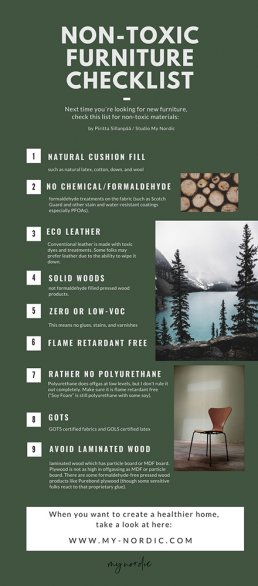
But I feel you, finding non-toxic furniture that’s both healthy and beautiful can take a while and little extra effort, especially if you’re used to visiting the more commonly recognised shops. But believe me, the pay off in the end is absolutely worth it. Not only will your non-toxic furniture contribute to a healthier home and increase your wellbeing, you’ll be filling your space with unique one-off pieces that you will absolutely love, they´ll will be your “life-partners” and you are happy about it every time you see it. So improve your quality of life and say bye bye to fast consumption!
Next time you´re looking for new furniture, you can start with this list for the material you want to look and check for:
- Natural cushion fill such as natural latex, cotton, down, and wool.
- No chemical/formaldehyde treatments on the fabric (such as Scotch Guard and other stain and water-resistant coatings especially PFOAs).
- Eco Leather – Conventional leather is made with toxic dyes and treatments. Some folks may prefer leather due to the ability to wipe it down.
- Solid woods, not formaldehyde filled pressed wood products.
- Zero or low-VOC glues, stains, and varnishes
- Flame retardant free but the picks here are all FR free.
- Polyurethane does offgas at low levels, but I don’t rule it out completely. Make sure it is flame retardant free (“Soy Foam” is still polyurethane with some soy).
- GOTS certified fabrics and GOLS certified latex.
- For non-toxic zero-VOC tables, chairs, bookcases, benches and storage units look for solid wood (with zero-VOC stains and varnishes), and zero or low-VOC adhesives.
- Low odor woods are preferable for some sensitive people.
- Avoid laminated wood which has particle board or MDF board. Plywood is not as high in offgassing as MDF or particle board.
- There are some formaldehyde-free pressed wood products like Purebond plywood (though some sensitive folks react to that proprietary glue).
- Some types of furniture are more likely to have a veneer of real wood glued on to a lower quality wood. In some styles this is hard to avoid.

